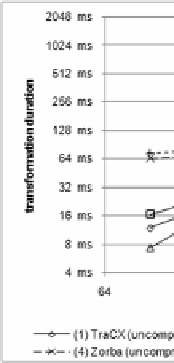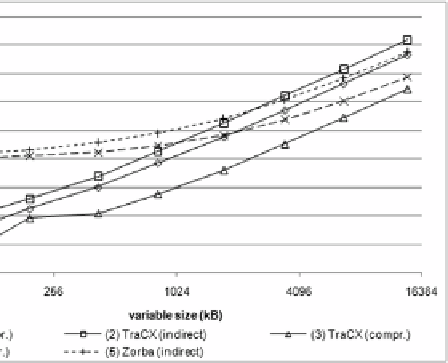Database Reference
In-Depth Information
number of <MinDistance>
the relative XPath expressio
Fig. 5 illustrates that fo
compressed and compresse
type implementation appea
expressions for compresse
increase of transformation
relative XPath expressions.
The third test uses XML
documents. The transforma
─
A1=/site/closed_aucti
─
A2 =//closed_auction/
─
A3 =/site/closed_auct
For each query Q
nodes and, thus, an increasing number of context nodes
on.
r N=10,000 our prototype implementation transforms
ed data faster than Zorba. In contrast to Zorba, our pro
ars to benefit from the automata based evaluation of XP
ed and uncompressed documents, resulting in a smo
duration for an increasing number of context elements
Our tests for N=1,000 returned similar results.
L files of variable size generated by XMark [6] as sou
ations reflect the following XPathMark [7] queries
ions/closed_auction/annotation/description/text/keyword
//keyword
tions/closed_auction//keyword
A2 , A3} the result of Q is embedded into an XQuery tra
s a <results> node as its root that contains a <result> n
ch query result R of Q .
s for
un-
oto-
Path
ooth
for
urce
d
{A1 , A
formation result that return
with R as its content for eac
∈
ans-
node
Fig. 6.
Duration for transform
cally scaled)
mation of Test 3, average of queries A1, A2, and A3 (logarith
hmi-
For all the three queries
erage of which is shown in
small uncompressed docu
documents. However, if co
output, our prototype imp
in contrast to Zorba, our p
formation duration.
of XPathMark, our tests yield very similar results, the
n Fig. 6. While our prototype implementation transfor
uments faster, Zorba is faster for large uncompres
ompressed documents are given as input and required
plementation is always faster than Zorba. Furthermo
prototype implementation reveals a linear growth of tra
av-
rms
ssed
d as
ore,
ans-


